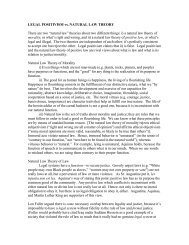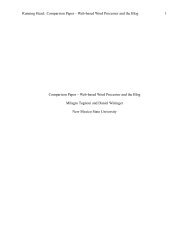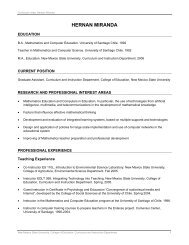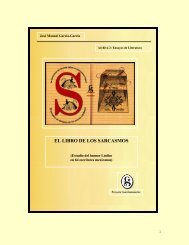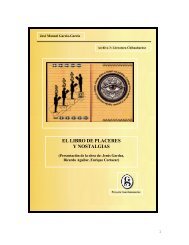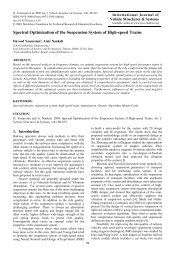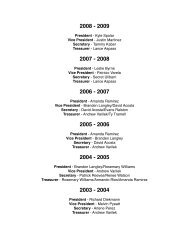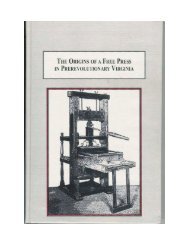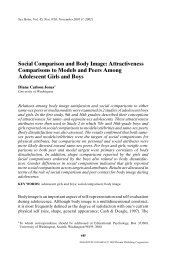You also want an ePaper? Increase the reach of your titles
YUMPU automatically turns print PDFs into web optimized ePapers that Google loves.
<strong>Paracas</strong> <strong>Textiles</strong><br />
Art 321<br />
Tess Bader<br />
4/20/2009
2<br />
On the coast of southern Peru lies the <strong>Paracas</strong> Peninsula. Roughly translated, <strong>Paracas</strong><br />
means “sand falling like rain.” 1 It was given this name because the only storms it ever sees are<br />
wind storms that blow the sand around. There is not one documented drop of rain in this area.<br />
The <strong>Paracas</strong> culture is known as the source of the most impressive pre-Columbian textiles in the<br />
world. These textiles are amazingly intricate and give us insight into the ancient <strong>Paracas</strong> culture.<br />
Most pieces were woven for everyday wear, but the majority of the remaining textiles were<br />
created for ceremonial or burial purposes. Hundreds have been found buried in the large <strong>Paracas</strong><br />
Necropolis. The fact that the ceremonial pieces were buried kept them far better preserved than<br />
pieces that were worn regularly. 2<br />
To understand both the social and technical importance of these textiles, we must analyze<br />
pieces from both the linear and block styles. We will first introduce the excavation site and then<br />
explore the techniques used to create examples from both styles found in the area. We will then<br />
analyze the motifs used. We must also explore the materials and tools used to create these<br />
masterpieces. To better understand the <strong>Paracas</strong> culture, it is important to also understand the<br />
principles of each style and the processes which were utilized in the creation of such fantastic<br />
textiles. Geography, religion, and social hierarchy each influenced the design of individual<br />
textiles. These three factors were far more significant than the artists’ preferences in creating<br />
these weavings.<br />
The <strong>Paracas</strong> were an Andean culture that began around 700BCE and lasted over six<br />
hundred years. The <strong>Paracas</strong> people were extremely advanced in more than just their weavings.<br />
1 Museum, The British. <strong>Paracas</strong>; Cloth and Culture. 2005.<br />
http://www.worldtimelines.org.uk/world/americas/south/1000-200BC/paracas (accessed March 24, 2009).<br />
2 Hagen, Adriana Von. Cities of the Ancient Andes. (London: Thames and Hudson Ltd. , 1998) pg 105
Agriculturally, they were leaders in utilizing rainfall from the Andes in local rivers for farming<br />
irrigation purposes. 3<br />
3<br />
This advanced farming allowed the <strong>Paracas</strong> people to grow their own<br />
cotton for their amazing weavings. Other materials, such as feathers, alpaca wool, llama wool,<br />
and beads were also used. These different materials were gathered and harvested in different<br />
areas in Peru, and traded among the neighboring Peruvian cultures. The wool, for example,<br />
came from animals that were raised in the Peruvian highlands and sheared once a year. This<br />
wool was then traded for coastal treasures like shells.<br />
The most valuable weavings were created using alpaca wool. Alpacas were known to<br />
produce the finest, strongest, and most durable wool out of all the animals in Peru. The fiber was<br />
also very easy to dye in up to forty shades using natural pigments such as leaves, bark, clay,<br />
bugs, and shellfish. It is important that the wool be sheared every other year before the rainy<br />
season began. The fact that each animal only produced about eight pounds of wool for the<br />
shearing makes alpaca fiber even rarer than cashmere. Another precious fiber was pima cotton,<br />
or gamuza. It was hand picked, which made it finer, smoother, and purer than the machine<br />
harvested cotton we have today. It is also very lustrous and took dyes well.<br />
Most evidence we have relating to these textiles was found by exploring the ancient<br />
tombs of the <strong>Paracas</strong> people that lay in the hills of the Cerro Colorado. These cemetery grounds<br />
cover an astounding 4000 square meters. The earlier Cavernas burial site (300BC-200AD) was<br />
smaller and was made up of bottle shaped caverns. These caverns held up to 37 mummies each.<br />
The most prestigious people were buried in the center of this pile of bodies. We know this<br />
3<br />
Kreft, Linda. Symbols of Authority. 2004. http://www.lindakreft.com/pef/paracas_lesson.pdf (accessed March 27,<br />
2009).<br />
4<br />
Museum, The Brooklyn. Before Columbus. 2008. http://beforecolumbus.net/brooklynmuseum.html<br />
4
ecause they were buried wrapped in the largest number of textiles as well as the highest<br />
quality. 5<br />
4<br />
However, the huge <strong>Paracas</strong> Necropolis had steep sides and was crowded with ancient<br />
remains and artifacts. This giant tomb was discovered by a Peruvian archeologist named Julio<br />
6<br />
Tello in the 1920’s. The Necropolis consists of a series of large burial chambers that held about<br />
40 mummies each. All of these mummies, over five hundred, were excavated with their knees<br />
tucked up under their chins (Fig. 1). 7<br />
Depending on the wealth of the deceased, the body was<br />
buried in several layers of exquisite <strong>Paracas</strong> textiles. Sometimes as many as sixty pieces were<br />
found on a single body, with the most intricate closest to the body. It is interesting that these<br />
garments were not worn by the deceased, but wrapped around them instead. The number of<br />
layers and the intricacy of the individual textiles signified the financial standing and social and<br />
political power of the deceased’s family. The more of these textiles that were owned in life, the<br />
more were included in the tomb after death. These mummies were extremely well preserved<br />
because of the lack of rain in the coastal deserts of Peru.<br />
Other offerings that were included in the burials were pottery, gold, silver, shells,<br />
feathers, and food. Offering food such as maize, peanuts, and yucca suggests that the <strong>Paracas</strong><br />
people wanted to nourish the deceased in the afterlife. It also suggests that they were hoping that<br />
if they fed the dead, the spirits would help them have a better harvest. Some of the weavings that<br />
were not buried with the dead were burned as a sacrificial offering to the spirits. They believed<br />
that these offerings would increase their chances of having a high yield when harvest time came.<br />
5 Miller, Rebecca Stone. Art of the Andes from Chavin to Inca. (London: Thames and Hudson Ltd. 1995) pg 63<br />
6 Anne Peters, <strong>Paracas</strong> Necropolis: Salvaging Contextual Relationships,<br />
http://www.doaks.org/research/pre_columbian/doaks_pco_project_grant_report_2005.html, (2008)<br />
7 Miller, Rebecca Stone. Art of the Andes from Chavin to Inca. (London: Thames and Hudson Ltd. , 1995) pg 53.
Also, motifs such as birds and transformational figures show that the <strong>Paracas</strong> people believed in<br />
communication between this life and the afterlife.<br />
5<br />
The spiritual importance of these textiles was only part of their value. They were worth<br />
more than even silver or gold to the tribe. Even after these tombs were compromised by grave<br />
robbers, there were still many exciting treasures to be discovered thanks to the perfect dry<br />
climate. Tello’s excavations unearthed hundreds of these exquisite ancient textiles in both linear<br />
style, and block style.<br />
Linear style began first, during the Cavernous phase in 300BC and lasted over four-<br />
hundred years and into the beginning of block style. Linear style is meant to be abstract and<br />
capture the essence of the subject matter, rather than naturalistic or representational of actual life.<br />
It is however, very much based on control, precision, and repetition. 8 They were commonly<br />
done in four main colors; red, green, gold, and blue. Linear textiles are usually done using a<br />
warp and weft technique with camelid fiber. A warp is a vertical thread that is strung onto the<br />
loom first. It is a supporting element in the textile and rarely carries patterning. A weft is a<br />
horizontal thread that is strung after the warp. It is not a structural element, as is used to be<br />
decorative. 9<br />
Unlike the block style pieces, linear garments had a sense of transparency. The weavers<br />
used figures such as felines, snakes, birds, steps, occulate beings, and faces that were nested<br />
within each other. This transparency caused intentional confusion and created a sense of<br />
8 Miller, Rebecca Stone. Art of the Andes from Chavin to Inca. (London: Thames and Hudson Ltd, 1995) pg 52<br />
9 Hagen, Adriana Von. Cities of the Ancient Andes. (London: Thames and Hudson Ltd, 1998) pg 106
interconnectedness between the figures and the ground cloth. This interconnectedness echoed<br />
the relationship between the <strong>Paracas</strong> people and their environment.<br />
6<br />
The poncho pictured in Figure 2 is decorated with two-headed birds and demonstrates<br />
transparency very clearly. In each of the rectangular motifs, four interlocked bird forms can be<br />
found. 10<br />
The first is the largest and most recognizable. Within the largest bird, there is a<br />
secondary, less detailed bird facing the opposite direction of the first. Next is the third bird,<br />
inside the second. It is more abstract and faces the same direction as its host. Finally, there are<br />
two matching, fully abstracted bird forms in the wings of the largest bird. There is also an<br />
alternating pattern of two similar bird forms around the neck hole and the perimeter of the<br />
poncho.<br />
On the other hand, block style is easily recognizable by the repetition of figures, with<br />
variations in color patterns. Up to nineteen colors were used in these pieces. This style is clear<br />
and legible, but is not nearly as restricted as linear style. Block style textiles began with outlines<br />
of the figures to be woven on top of the background piece. Weavers used a stem stitch system<br />
that consisted of overlapping diagonal stitches that covered large areas of the contrasting ground<br />
11<br />
color. These outlines were filled in according to a complex pattern of alternating colors. Even<br />
though each textile repeated only a single figure, having this variety kept the figures consistent<br />
without allowing them to become monotonous. 12<br />
The elaborate figures were usually done in<br />
curvilinear shapes. The design elements and figures were woven from observation to represent<br />
10<br />
Rebecca Stone-Miller, To Weave for the Sun, (Boston, Museum of Fine Arts, 1992) pg 72<br />
11<br />
Miller, Rebecca Stone. Art of the Andes from Chavin to Inca. (London: Thames and Hudson Ltd, 1995) pg 54<br />
12<br />
Rebecca Stone-Miller, To Weave for the Sun, (Boston, Museum of Fine Arts, 1992) pg 30
actual events and people. Block style does not utilize transparency, but pushes ideas of ritual<br />
transformation, superhumans, and shaman. 13<br />
7<br />
One of the most celebrated block style textiles is an embroidered mantle that features a<br />
pattern of ornate bird impersonators (Fig. 3). Each impersonator has trophy heads on his wings<br />
and is pictured holding snakes. They also have talon clad feet like a predatory bird. This<br />
probably represents the power of the bird as a hunter. The bird impersonators each have a<br />
headdress and arrow shaped kennings on each side of their legs. This mantle was actually<br />
discovered in 1917, thirteen years before the excavation of the <strong>Paracas</strong> Necropolis in a cemetery<br />
south of Pisco.<br />
This article was mapped out using several closely woven rows of stem threads which<br />
creates a dense color and obscures the background color entirely. It remains unfinished, and this<br />
gives us insight into the process of creating such a textile and the order its stitches were<br />
completed in. It has a matching skirt that also remains unfinished. This garment was probably<br />
worked on by several weavers, as most textiles were at that time. The cooperative work of many<br />
weavers suggests that the cloth itself was more important than the tribe member that created it<br />
receiving credit. These pieces represented an entire clan, rather than an individual weaver. 14<br />
Notice that when they are compared, both of these superb examples of <strong>Paracas</strong> weaving<br />
share a motif involving birds. It was believed that birds were the most powerful animal because<br />
they had the gift of flight. Birds are able to travel between the earth’s three major habitat areas;<br />
land, water, and sky. Ancient <strong>Paracas</strong> people saw this as a sign that birds could also travel<br />
13 Miller, Rebecca Stone. Art of the Andes from Chavin to Inca. (London: Thames and Hudson Ltd. , 1995) pg 56<br />
14 Rebecca Stone-Miller, To Weave for the Sun, (Boston, Museum of Fine Arts, 1992) pg 79
etween the worlds of the living and the dead. Bird motifs were showcased on so many of these<br />
textiles because of this idea of duality and communication with the spirits. There may be more<br />
than one reason that the <strong>Paracas</strong> people would want to contact the dead, but most likely they<br />
were asking for good fortune with agricultural harvests.<br />
8<br />
Some of the other, less celebrated textiles were done using techniques such as knotting<br />
and braiding. These practices were also frequently used in conjunction with other weaving<br />
techniques to create fringe. They also created netting, beadwork, tabbing, looping, and more.<br />
The basket in Figure 4 was found in a woman’s grave and contains tools for every step in<br />
creating a textile. For example, there is unspun fiber, spinning tools, spun thread, a needle,<br />
ceramic cup, and chalk. This basket must have belonged to a very skillful master weaver. Even<br />
the craftsmanship used in creating these tools goes beyond utilitarian needs by incorporating<br />
decorations that follow the same themes as the pieces to be woven. 15<br />
One thing that remained constant, no matter the material or technique, was that the textile<br />
itself was representative of the entire clan, rather than the weaver who created it. Also, the<br />
process of the weaving was more important than being efficient. It has been estimated that<br />
anywhere between 5,000 and 29,000 hours were spent on each textile. It seems that <strong>Paracas</strong><br />
16<br />
people devoted their lives to honoring the dead.<br />
Many <strong>Paracas</strong> techniques are so advanced that<br />
they still have yet to be replicated. The <strong>Paracas</strong> people will probably always remain unmatched<br />
in skill and craftsmanship because they created their textiles for secular purposes, to honor the<br />
tribe, and to create connections with the material and spiritual worlds alike.<br />
15<br />
Rebecca Stone-Miller, To Weave for the Sun, (Boston, Museum of Fine Arts, 1992) pg 70<br />
16<br />
Kreft, Linda. The Culture of the <strong>Paracas</strong>; The Power of Garments. 2004.<br />
http://www.lindakreft.com/ancestors.html (accessed March 27, 2009).
Figure 1 17<br />
These Necropolis mummy bundles consisted of a body, seated in a basket, and wrapped with<br />
exquisite textiles. Hundreds were found buried in the Cerro Colorado hills.<br />
17 Miller, Rebecca Stone. Art of the Andes from Chavin to Inca. (London: Thames and Hudson Ltd. , 1995) pg 52-53<br />
10
Figure 2 18<br />
This linear style poncho is a prime example of transparency. The abstract bird figures are nested<br />
inside each other to communicate an idea of interconnectedness with environmental<br />
surroundings.<br />
18 Miller, Rebecca Stone. To Weave for the Sun. (Boston: Museum of Fine Arts, 1992) pg 72<br />
11
Figure 3 19<br />
This block style mantle features a bird impersonator theme that is consistent with ideas of<br />
transformation and communication between worlds.<br />
19 Miller, Rebecca Stone. To Weave for the Sun. (Boston: Museum of Fine Arts, 1992) pg 79<br />
12
Figure 4 20<br />
This basket contains all of the advanced tools for a professional Pre-Columbian weaver. It is a<br />
beautiful example of craftsmanship in an area besides actual textiles.<br />
20 Miller, Rebecca Stone. To Weave for the Sun. (Boston: Museum of Fine Arts, 1992) pg. 69<br />
13
Bibliography<br />
Hagen, Adriana Von. Cities of the Ancient Andes. London: Thames and Hudson Ltd. , 1998.<br />
Harley, John. The History of Cartography. Chicago: University of Chicago Press, 1998.<br />
Kreft, Linda. Symbols of Authority. 2004. http://www.lindakreft.com/pef/paracas_lesson.pdf (accessed<br />
March 27, 2009).<br />
—. The Culture of the <strong>Paracas</strong>; The Power of Garments. 2004.<br />
http://www.lindakreft.com/ancestors.html (accessed March 27, 2009).<br />
Merrin, Samuel and Edward. "The Awe-Inspiring <strong>Textiles</strong> of <strong>Paracas</strong>." Re/Collections. New York: The<br />
Merrin Gallery, 1994.<br />
Miller, Rebecca Stone. Art of the Andes from Chavin to Inca. London: Thames and Hudson Ltd. , 1995.<br />
Miller, Rebecca Stone. To Weave for the Sun. Boston: Museum of Fine Arts, 1992.<br />
Museum, The British. <strong>Paracas</strong>; Cloth and Culture. 2005.<br />
http://www.worldtimelines.org.uk/world/americas/south/1000-200BC/paracas (accessed March 24,<br />
2009).<br />
Museum, The Brooklyn. Before Columbus. 2008. http://beforecolumbus.net/brooklynmuseum.html<br />
(accessed March 19, 2009).<br />
Paul, Anne. <strong>Paracas</strong> Art and Architecture: Object in Context in South Coastal Peru. Iowa: University of<br />
Iowa Press, 1991.<br />
Peters, Anne. <strong>Paracas</strong> Necropolis; Salvaging Contextual Relationships. 2005.<br />
http://www.doaks.org/research/pre_columbian/doaks_pco_project_grant_report_2005.html (accessed<br />
April 1, 2009).<br />
Reed, James. "Siguas <strong>Textiles</strong>; Mystery and Magic." Tribal Arts, August 2006: 122.<br />
T.G. "Gallery Guide." Rhode Island: Rhode Island School of Design.<br />
Wilson, Kax. A History of <strong>Textiles</strong>. Boulder: Westview Press, 1979.<br />
14



